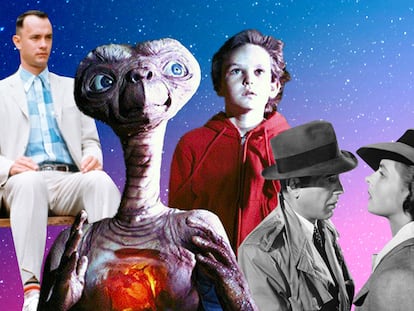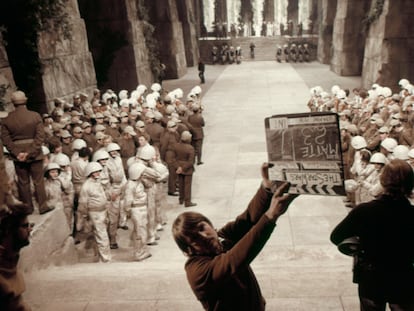‘Flash Gordon,’ the ‘kitsch’ fantasy from the planet Mongo that paved the way for ‘Star Wars’
The comic series created by Alex Raymond returns to bookstores with two carefully-crafted editions on the 90th anniversary of its creation
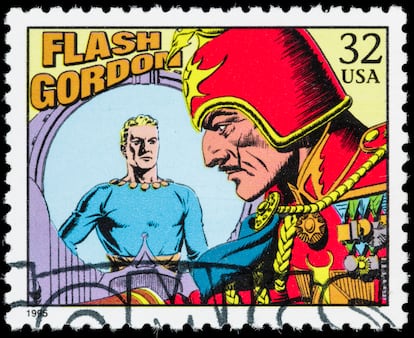
On January 7, 1934, Flash Gordon — one of the most recognizable science fiction comic icons — began to be published in the American press. And, nine decades later, two careful collector’s editions have been released, to revive a character who was always present at the newsstands.
The Flash Gordon series appeared at a time when the American public wasn’t in a very humorous mood, given that most citizens had been going through a difficult time since the Wall Street Crash of 1929. As a result, the comics that filled the Sunday supplements began to move from portraying everyday life to instead embracing overflowing fantasy. Exotic scenarios helped readers evade an unbearable reality.
In that context, the all-powerful King Features Syndicate (KFS) launched a series dedicated precisely to meeting that need, betting on the talent of a young cartoonist named Alex Raymond. With scripts by Don Moore — an experienced in-house screenwriter — Flash Gordon was clearly inspired by the novel When Worlds Collide, by Edwin Balmer and Philip Wylie.
The premise is as follows: while the planet Mongo is approaching the Earth at full-speed, a plane has an accident and the athletic Flash Gordon survives. along with the beautiful Dale Arden. The two end up being kidnapped by Professor Zarkov, who attempts to launch a spaceship against the dangerous planet that is about to collide with the Earth.
Upon arriving to the planet Mongo, the series quickly drifts into a fantasy as naive as it is indebted to Edgar Rice Burroughs’ John Carter of Mars, the fictional protagonist of the Barsoom serialized novels. But Raymond’s dense lines gradually evolved towards a spectacular graphic Baroquism, with the comic strips becoming sumptuous works of art from which it was impossible to escape. The success was immediate and, in a few months, the series not only became one of the great hits in the United States, but also in the entire world. With a delay of just a few months, the adventures of the blonde protagonist appeared translated in France, Italy and Spain.
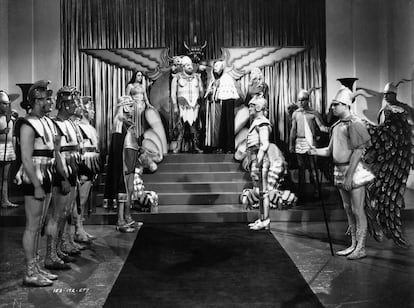
In these adventure comics, film productions companies found perfect material to bring to the big screen. In 1936, Universal produced a successful film series starring Buster Crabbe, faithfully adapting the plots that were published in the press. This paved the way for two other series in later years. The passion for these American comics was so great in Europe that, when the materials stopped arriving during World War II, local cartoonists — such as Edgard P. Jacobs in France, or Jesús Blasco in Spain — were commissioned to continue the comics that had been cut off.
Graphic influence
When Raymond was called up for military service, the series was left in the hands of Austin Briggs, who maintained the popularity of Flash Gordon even when the original artist returned from the war and decided to create a new work: Rip Kirby. But at that point, Raymond had already developed his own iconography and a style that had a decisive influence on the world of comics. From a visual point of view, the creation and composition of the pages of Flash Gordon were largely based on the science fiction ideas that the Star Wars series later included. In fact, at one point, George Lucas even wanted to make a film adaptation of Flash Gordon, but he was denied the rights.
But even more important was Raymond’s influence among graphic artists. Virtually all superhero comic artists drew on his work. In the 1950s, the series was no stranger to the new trends in science fiction. Led by Dan Barry and his talented studio — which brought together screenwriters such as Harvey Kurtzman and Harry Harrison with artists like Al Williamson, Frank Frazzetta, or Bob Fujitani — the series achieved a new period of splendor, with modern plots that opted for a more realistic version of science fiction. The falcon men and lion men were left behind, replaced by technology, which became a reference point for subsequent issues. It’s easy to find influences from this stage in the plots and characters in the early comics of Marvel’s The Fantastic Four.

In Spain — unlike in most countries — interest in the series hasn’t faded. By the end of the 1950s, Editorial Dólar launched its legendary collection Modern Heroes, in which Barry’s work began to be published and Raymond’s era was recovered (although the censorship imposed by the Franco dictatorship took care to lengthen skirts, hide necklines and omit passions between certain characters). During the 1960s, Dólar republished the series in different formats, including the pioneering “Graphic Novels for Adults,” to avoid the strict controls over comics that the authorities maintained.
But the passion for Flash Gordon didn’t wane in Spain even by the 1970s. The Buru Lan publishing house put a collector’s edition of Raymond’s sagas on the market, recolored and with an inappropriate — but highly successful — re-editing.
And while the series no longer aroused the same fervor in the US (despite the fact that the creators tried to add Flash to the trend of superheroes by forming a group with Mandrake and The Masked Man), the affection for the character — and, above all, the box office pull of George Lucas’ films — encouraged Dino de Laurentiis to return to an old project he had, to adapt the mythical comic book character with Federico Fellini. However, it never came to fruition.
After trying to get directors like Nicholas Roeg or Sergio Leone to take on the project, it would ultimately be Mike Hodges who would be in charge of bringing the comics to the screen. The final result was as irregular as it was memorable, thanks to the soundtrack by Queen. Today, it’s an iconic work in the cult of kitsch.
The undoubted popularity of the 1980 film adaptation brought Flash back to newsstands. It has continued to be published ever since. In fact, in Spain, it remains the most-published American comic series. And interest in the character is still alive in the country where it was created, to the point that KFS has recently relaunched the series for the US press at the hands of cartoonist Dan Schkade, seeking to recover a younger reading audience with a fresh drawing style, along with more modern and relatable plots. There’s also a new esthetic that comes from years of manga and animation production.
As Queen sang. Gordon will continue to be the savior of the universe and king of the impossible. We can continue singing heartily: “Flash! A-ah! He’s a miracle!”
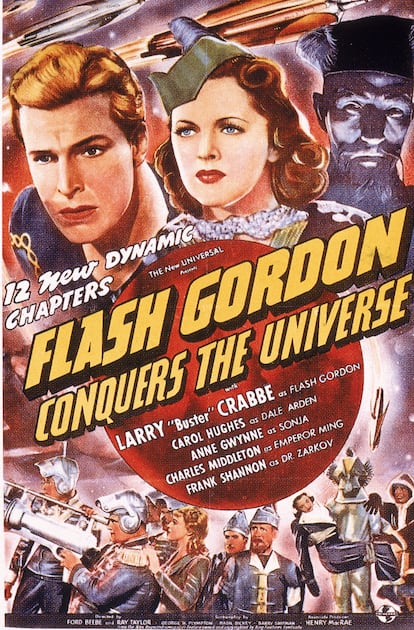
Sign up for our weekly newsletter to get more English-language news coverage from EL PAÍS USA Edition
Tu suscripción se está usando en otro dispositivo
¿Quieres añadir otro usuario a tu suscripción?
Si continúas leyendo en este dispositivo, no se podrá leer en el otro.
FlechaTu suscripción se está usando en otro dispositivo y solo puedes acceder a EL PAÍS desde un dispositivo a la vez.
Si quieres compartir tu cuenta, cambia tu suscripción a la modalidad Premium, así podrás añadir otro usuario. Cada uno accederá con su propia cuenta de email, lo que os permitirá personalizar vuestra experiencia en EL PAÍS.
¿Tienes una suscripción de empresa? Accede aquí para contratar más cuentas.
En el caso de no saber quién está usando tu cuenta, te recomendamos cambiar tu contraseña aquí.
Si decides continuar compartiendo tu cuenta, este mensaje se mostrará en tu dispositivo y en el de la otra persona que está usando tu cuenta de forma indefinida, afectando a tu experiencia de lectura. Puedes consultar aquí los términos y condiciones de la suscripción digital.
More information
Archived In
Últimas noticias
Most viewed
- Sinaloa Cartel war is taking its toll on Los Chapitos
- Reinhard Genzel, Nobel laureate in physics: ‘One-minute videos will never give you the truth’
- Oona Chaplin: ‘I told James Cameron that I was living in a treehouse and starting a permaculture project with a friend’
- Why the price of coffee has skyrocketed: from Brazilian plantations to specialty coffee houses
- David King, chemist: ‘There are scientists studying how to cool the planet; nobody should stop these experiments from happening’
